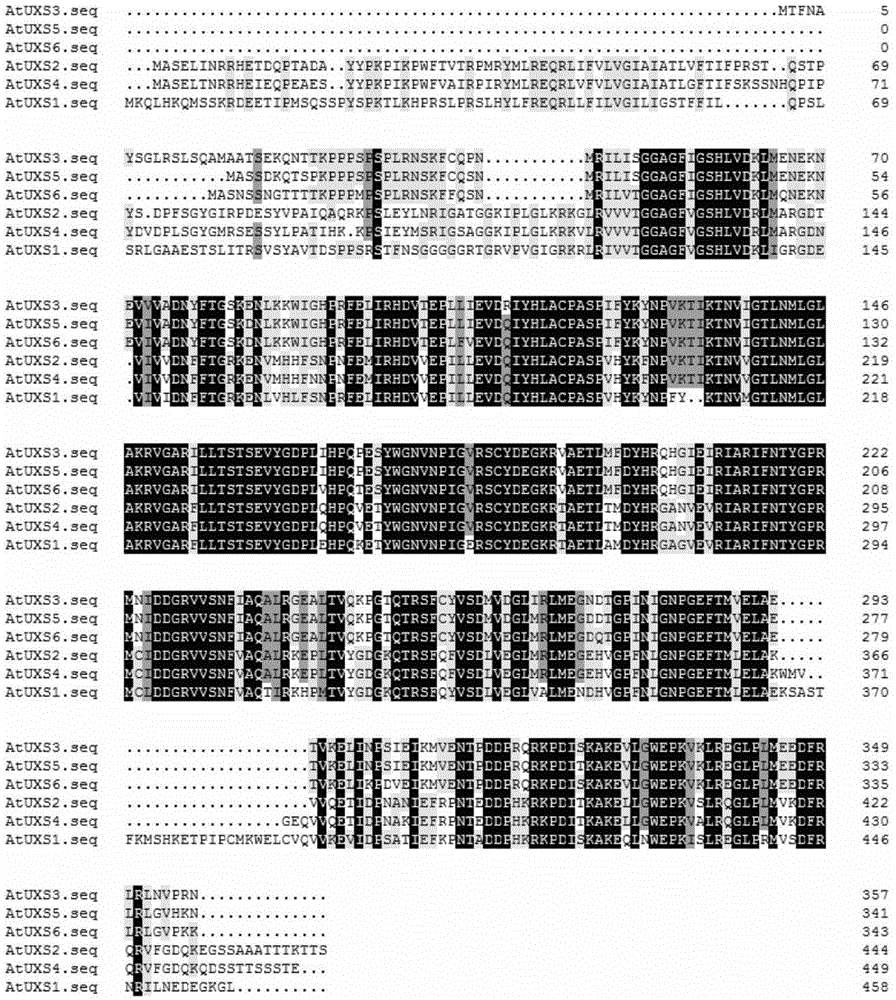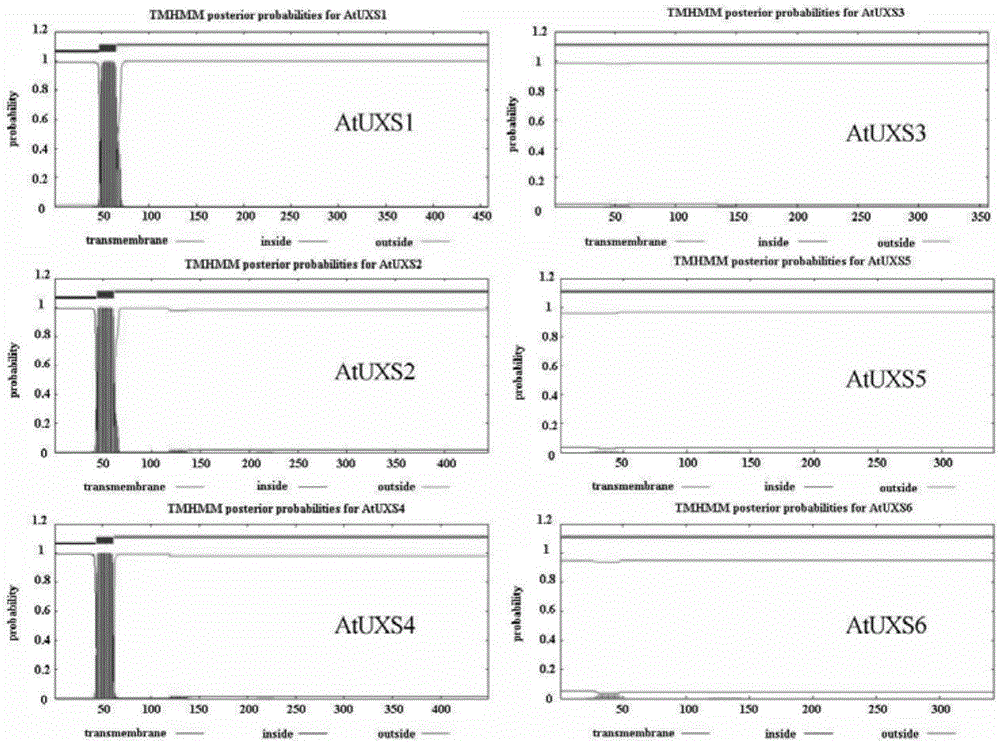Method for improving plant saccharification efficiency and application of method
A technology for saccharification efficiency and plant sugar, which can be applied in the directions of botanical equipment and methods, applications, and plant products, and can solve problems such as affecting saccharification efficiency.
- Summary
- Abstract
- Description
- Claims
- Application Information
AI Technical Summary
Problems solved by technology
Method used
Image
Examples
Embodiment 1
[0037] Bioinformatic analysis of six UXS proteins in Arabidopsis. Using DNAMAN software to analyze the homology of the amino acid sequence of AtUXS (SEQIDNO: 2, 4, 6, 8, 10, 12), it is found that the amino acid sequence similarity of AtUXS3, AtUXS5 and AtUXS6 is: 91.97%; AtUXS1, AtUXS2 and AtUXS4 amino acid The sequence similarity is: 75.94%, and the similarity between the two groups is relatively small ( figure 1 ). Furthermore, the transmembrane regions of the six AtUXS proteins were predicted (TMHMM, http: / / www.cbs.dtu.dk / services / TMHMM / ), AtUXS1, AtUXS2 and AtUXS4 have transmembrane regions and are located in the Golgi apparatus, AtUXS3, The three proteins AtUXS5 and AtUXS6 have no transmembrane region and may be localized in the cytoplasm ( figure 2 ).
Embodiment 2
[0039] The subcellular localization of 6 AtUXS was carried out by tobacco injection method. The cDNA sequences of 6 ATUXS (SEQ ID NO: 1, 3, 5, 7, 9, 11) were amplified with the primers shown in Table 1 respectively.
[0040] Table 1 Amplifies the primers of the cDNA sequences of 6 ATUXS
[0041] name
[0042] Six AtUXS were constructed into the plant expression vector pEarlyGate101 (ABRC, Arabidopsis Biological Resource Center) by using Gateway technology, and AtUXS could be fused with YFP for expression because the stop codon was removed. The constructed vector was transformed into Agrobacterium agrobacterium C58 (Agrobactreium tumefaciens C58) (purchased from Shanghai Dingguo Biotechnology Co., Ltd.), and subcellular localization was carried out by tobacco injection. Three proteins AtUXS3, AtUXS5 and AtUXS6 were directly injected into tobacco leaves, and three proteins AtUXS1, AtUXS2 and AtUXS4 were co-injected with Golgi Marker CD3-968 (purchased from ABRC, Arabi...
Embodiment 3
[0044]Acquisition of AtUXS-mutated T-DNALine. 从ABRC(ArabidopsisBiologicalResourceCenter)订购到6个AtUXS的突变体:uxs1(N555603,Salk_055603,sixthintron),uxs2(N503691,Salk_003691,firstexon),uxs3(N907654,WiscDsLoxHs080_09,fifthexon),uxs4(N609630,Salk_109630,fifthintron), uxs5(N850623, WiscDsLox293-296invD4, eighthintron) and uxs6(N678548, salk_058602, secondintron)( Figure 4 A). In SALK (SalkInstituteGenomicAnalysisLaboratory, http: / / signal.salk.edu ) website to synthesize corresponding T-DNALine identification primers, as shown in Table 2.
[0045] Table 2 T-DNALine Identification Primers
[0046] Primer Codes
Primer sequence 5′→3′
N555603F
CTGAATTGCTCTATCCAACGG
N555603R
TCACAATGCTTGAACTTGCAG
N503691F
CAAGAAAACATGCACGTGTTG
N503691R
CTTACTCGGATCCTTTCTCCG
N907654F
TGATAGGGCCAGTATCATTGC
N907654R
GCTTCATTGGTTCTCACTTGG
N609630F
GGTCCTTTAATCGTACGGCTC
N609630R
ACCAAGGTTAAATGGACCGAC
N850...
PUM
 Login to View More
Login to View More Abstract
Description
Claims
Application Information
 Login to View More
Login to View More - R&D
- Intellectual Property
- Life Sciences
- Materials
- Tech Scout
- Unparalleled Data Quality
- Higher Quality Content
- 60% Fewer Hallucinations
Browse by: Latest US Patents, China's latest patents, Technical Efficacy Thesaurus, Application Domain, Technology Topic, Popular Technical Reports.
© 2025 PatSnap. All rights reserved.Legal|Privacy policy|Modern Slavery Act Transparency Statement|Sitemap|About US| Contact US: help@patsnap.com



